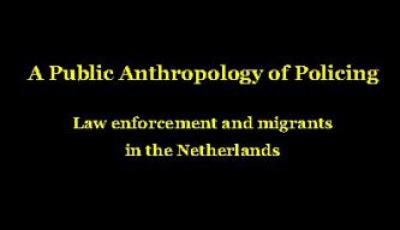Book Review: A Public Anthropology of Policing: Law Enforcement and Migrants in the Netherlands
Posted:
Time to read:
Post by Synnøve Økland Jahnsen, Postdoctoral Research Fellow at the Norwegian Police University College.
Review of A Public Anthropology of Policing: Law Enforcement and Migrants in the Netherlands by Paul Mutsaers (Politieacademie/Tilburg University, 2015).

Having spent six years interviewing and observing police officers and their leaders across a variety of cities and small towns in the Netherlands, Mutsaers’ main finding is that Dutch policing practices preserve and consolidate an established social order that deprives migrants of rights of equal access to and contact with the police. He also makes the case that a frontline organization such as the police needs frontline academics who engage in what he calls a ‘public anthropology of policing.’ This engagement would not only raise the game by engaging more with the wider public, but also include the subjects of the research, in this case the police.
According to Mutsaers, a public anthropology of policing must fulfill four criteria which can be broadly outlined as: accessibility of outcomes, transparency, questioning the familiar, and addressing issues of importance to the public.
The first criterion relates to how research findings are written and communicated. His own contribution is both well-structured and clearly written in a language seeking to render anthropological work accessible to a non-academic audience. The second criterion concerns the need to be as open and transparent about the research process as possible. However, researchers must be mindful of the ordering of truth claims, and what informants choose to conceal or disclose when engaging with participants. Third, Mutsaers points out that while anthropology traditionally has been concerned with making the strange familiar, a public anthropology of the police should aim to ‘make the familiar strange’ (2015:12). This means challenging categories and phenomena that are often taken for granted. As such, he strives to ‘unthink’ and ‘de-familiarize’ the bureaucracy-bashing that’s currently going on in the Dutch police, outlining the serious consequences that it has in terms of equality, neutrality, and impartiality. In this sense, his argument is that a public anthropologist should take the position of speaking against power while interrogating received wisdoms. Finally, a public anthropology of policing, Mutsaers argues, should address critical issues, that is, those of importance to the public. Such critical issues should be addressed pragmatically, and with a practical objective in mind. For Mutsaers, this has meant focusing on issues pertaining to security and control. Yet, it should be pointed out that Mutsaers has served both as a researcher and lecturer at the Police Academy of the Netherlands. In that sense, he has not shied away from engagement with, nor feelings of debt to, his field of research.
The monograph is structured into nine chapters, the first three of which lay out the theoretical and conceptual grounds for the empirical cases discussed in the following chapters. Taken together, the empirical chapters describe and analyze the policing of migrant communities while simultaneously allowing the reader to get acquainted with the stories of several subjects: Superintendent Dinesh who isn’t promoted team leader because his superiors consider him inauthentic; Senior Constable Meyrem who’s side-tracked for being too assertive; Sergeant Ayse and Superintendent Aziza who are aggressively approached by their colleagues because of their religious affiliation and who don’t feel supported by their leaders when trying to defend themselves; and Senior Constables Fehim and Haili who both tried to cope with the tension between their private selves and their public roles. Most tellingly, we learn about Inspector Mo who due to his ethnic background is encouraged by his superiors to blur the boundaries between his public and private lives. This blurring leads him to work in private clothes, distribute his cell phone number among neighborhood residents, and know pretty much everybody in the community he polices and surveils because this is where he himself lives.
Mutsaers’ analysis of these stories highlights how the advent of ‘psy-frames’ is increasingly rendering police work and police officers psychologized while simultaneously blurring the boundaries between private and public issues. As a final remark, he quotes Lionel Tilling: ‘A false good is more dangerous than actual evil,’ pointing towards his concerns that the ‘inclusion’ of ‘selves’ or personality isn’t limited to what he sees as the processes of de-bureaucratization of the police force. It’s precisely the same form of blurred boundaries between private and public spheres that promotes an increased surveillance of the populations the police are supposed to protect and serve.
In short, A Public Anthropology of Policing can be described as nothing less than an excellent, inspiring, critical, and thought-provoking contribution to our knowledge about the policing of diversity and migration, both within the police as well as external to its organization. Although the book speaks specifically to questions related to border control, ethnic relations and the police, it also has more general qualities that make it a useful read for anyone with an interest in police studies, criminology, anthropology, sociology, public policy, and administration.
This book is available online here.
Any comments about this post? Get in touch with us! Send us an email, or post a comment here or on Facebook. You can also tweet us.
__________
How to cite this blog post (Harvard style):
Jahnsen, S.O. (2016) Book Review: A Public Anthropology of Policing: Law Enforcement and Migrants in the Netherlands Available at: https://www.law.ox.ac.uk/research-subject-groups/centre-criminology/centreborder-criminologies/blog/2015/11/book-review-1 (Accessed [date]).
Share:








